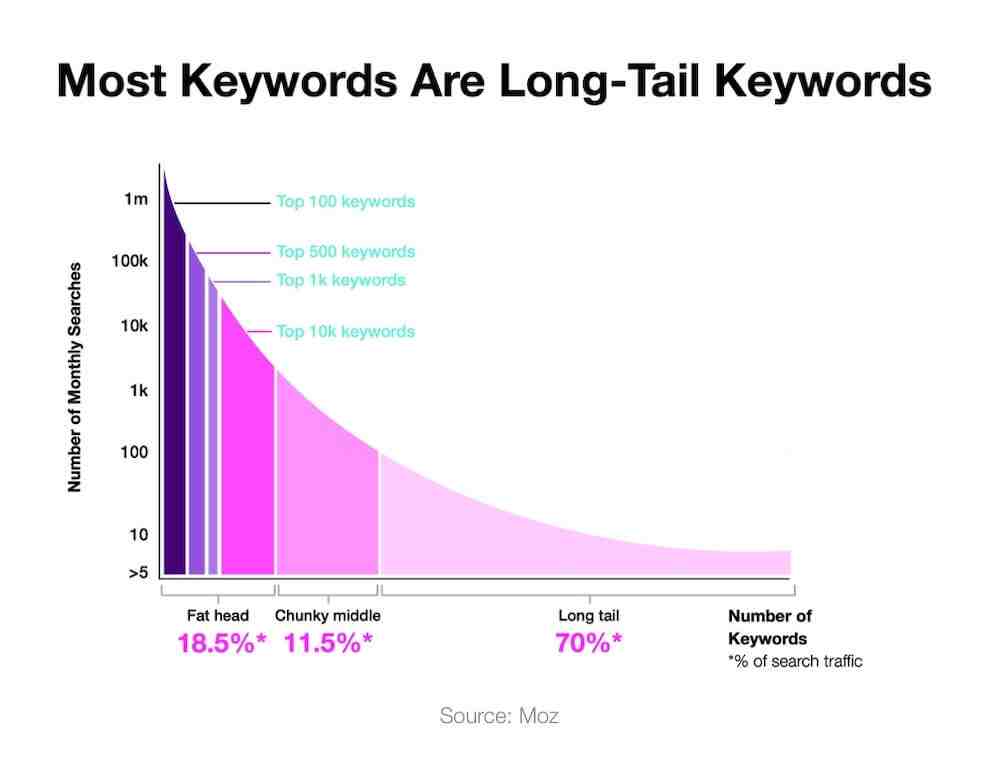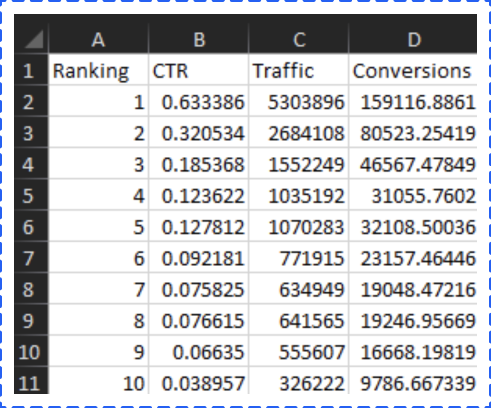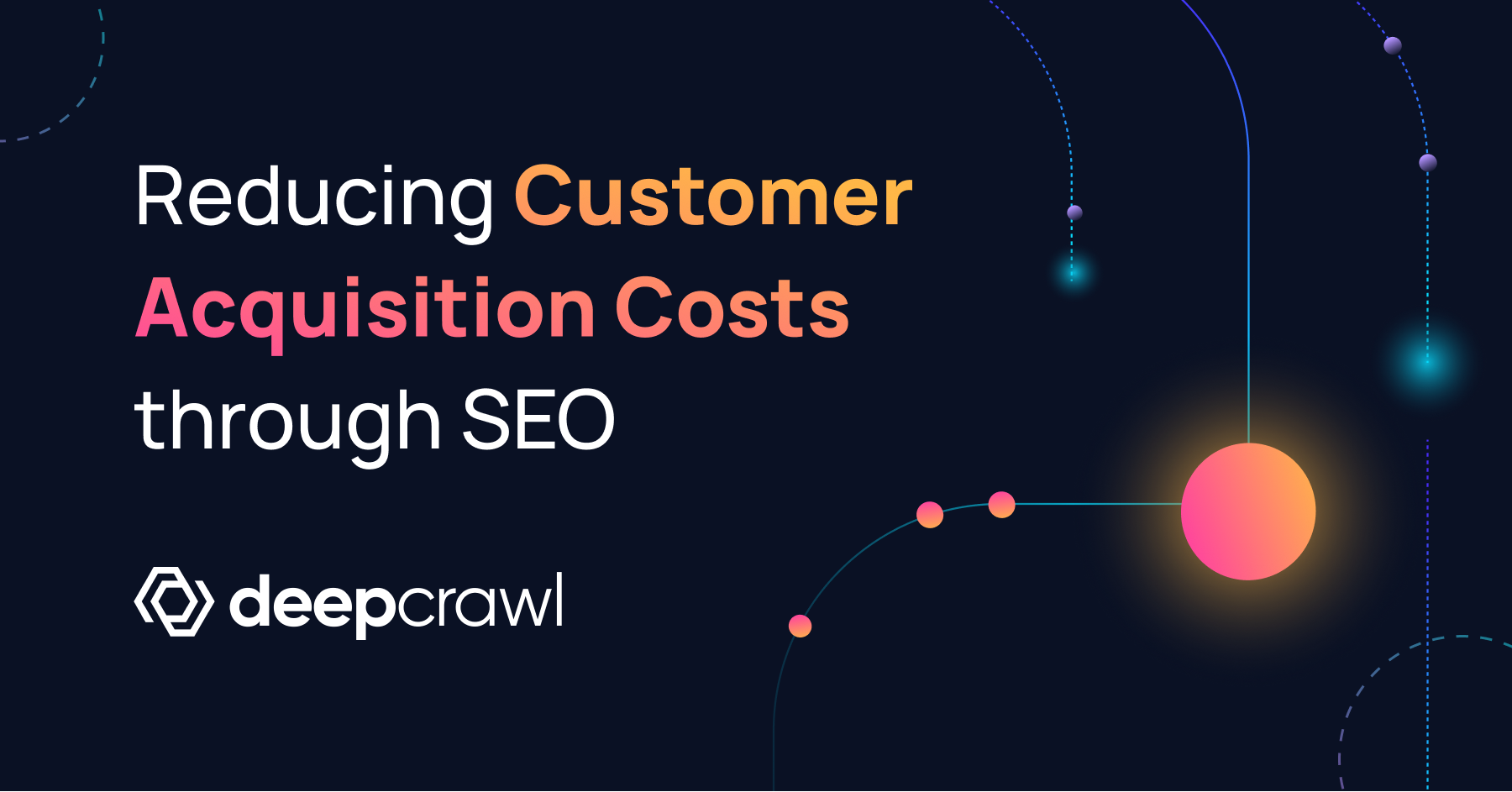1. Use SEO Forecasting During SEO Strategy Creation To Validate Attainable Goals
Contents
- 1 1. Use SEO Forecasting During SEO Strategy Creation To Validate Attainable Goals
- 2 2. Uncover New Business Opportunities With SEO Forecasting
- 3 3. Use Predicted SEO Forecasts To Help Business Decisions
- 4 Use SEO Forecasting To Show Business-Wide Needs For SEO
- 5 What is a good percentage increase in website traffic?
- 6 What percentage is organic traffic?
- 7 How much content is good for SEO rankings?
- 8 How does Google Analytics measure organic traffic?
- 9 What is time series forecasting in data science?

Your first step to building your SEO strategy is to choose your goals and objectives.
These goals should be the North Star that every part of your strategy is working towards.
You probably had to answer questions related to business goals such as:
By using SEOmonitor forecasts, you can answer these questions and secure your value as a thought leader.
Plus, you’ll be able to explain these metrics, set expectations, and provide insight into how best to invest your marketing dollars.
With the answers to these questions in your pocket, you can start laying the foundation for a highly understandable SEO strategy that stakeholders will love.
As I’m personally a fan of the “SMART goals” framework, I recommend using it to strategize because it forces you to consider whether your goals are truly measurable and achievable.
An example to guide you might be: “Increase non-branded organic search traffic by X% in 12 months and Y% in 24 months, while improving website conversion rate by Z% for our goals agreed conversion rates.”
How To Validate Your SEO Objectives
Let’s take an example to understand how forecasting helps to create and explain these measurable and specific goals.
In this example, I’m working on a property and real estate website, which I’ll call “Property Search”.
Property Search receives approximately 5 million organic search sessions per year.
Now that you have your questions in mind, you can use SEO predictions to help you make sure those metrics and goals are truly achievable.
Define your keyword data at a granular level
The more granular you structure your keyword data, the better.
Define your information architecture and group strategic groups of search phrases.
SEOmonitor provides a structure of folders and groups, which helps you configure the level of granularity you need.
Image by SEOmonitor, September 2022
This level of granularity allows you to create different forecasting scenarios based on your selection of specific folders or groups. This is how you can validate relevant metrics against different goals.
In order to forecast the metrics for my first goal – “maintain and grow the non-branded organic search traffic the site is already receiving” – I start the forecasting process in SEOmonitor with the folders and groups I have structured and that relate to “Property Search’s” current organic search footprint.
Image by SEOmonitor, September 2022
Create & Test a reliable SEO strategy scenario
The SEOmonitor forecasting solution provides you with all the key variables you need to create a reliable scenario:
A key part of the forecasting process is the ability to adjust the conversion rate in the SEOmonitor forecasting algorithm.
Sometimes, when you know a brand, your expertise can help you tailor forecasts towards a more accurate prediction.
For example, one issue I’ve encountered in the past is that conversion data in Google Analytics doesn’t match data in internal systems, in some cases by 20-30%. In this case, adjusting the conversion rate you forecast results in much more accurate measurements in the final forecast.
Image by SEOmonitor, September 2022
The resulting forecast scenario provides me with all the data necessary to answer the questions mentioned above, validate my first objective and provide valuable information to my client.
2. Uncover New Business Opportunities With SEO Forecasting

Based on this initial forecast scenario, we can now turn our attention to the second goal I described: “Increase non-branded organic search traffic for new areas of opportunity.”
How To Identify Gaps In Your Competitor’s SEO Strategy
After extensive research into new areas of opportunity for “ownership research” and the identification of clusters of business-related keyword phrases, we have identified feasible gaps in the competitor landscape.
We consider the gaps achievable due to the company’s level of authority in the competitive landscape.
Image by SEOmonitor, September 2022
3. Use Predicted SEO Forecasts To Help Business Decisions

Working with the Director of Sales at Property Search, we were able to use data from both scenarios to predict how much revenue the site would generate based on increased conversions.
Based on the estimated increase in off-brand traffic, we are also able to factor in the increase in their display ad revenue from advertisers on their site.
All of this impacts the ability to forecast better ads and make board-level decisions about the best areas for marketing investment.
Finally, you might be wondering why we didn’t put these two forecast scenarios together, which is a good question.
The reason is that the two objectives we had required different tactics to succeed:
The ability to assign these goals to specific stakeholders within the ‘Property Finder’ team allowed for better accountability and clarity on who was responsible for delivery in each area of our strategy.
Use SEO Forecasting To Show Business-Wide Needs For SEO

SEO prediction based on desired keywords and ranking goals allows you to set clear, measurable goals and make a solid business case for:
This further translates into potential business outcomes that are of interest to customers and stakeholders.
This is how you turn the conversation from SEO as a cost to SEO as an investment.
With SEOmonitor forecasts, which take into account all the key variables influencing your keywords and rankings (device segmentation, search data including seasonality and year-over-year trends, CTRs and conversion rates), you can check every calculation and trust the data.
Join us if you want to create more value for your customers and stakeholders with more transparency and precision.
The opinions expressed in this article are those of the sponsor.
The goal of SEO is to rank your website in organic search results. You can also place your website in the paid area of search results via pay-per-click (PPC). SEO is where you focus 100% on ranking in organic results.
What is a good percentage increase in website traffic?

As with many metrics, website traffic growth will vary significantly by business stage and audience. However, a monthly growth rate of 10-20% is generally considered a good benchmark.
What is a good KPI to increase site traffic? 1. Website traffic ratio. The website traffic lead ratio gives you information on how many visitors to your website have become qualified leads. This is one of the best KPIs for digital marketing and it is useful because it tells you more about the quality of visitors to your website.
What is considered a lot of website traffic?
They say the rule of thumb for your average small business in our industry is 1,000 visitors per month. If you get 1,000 visitors per month, that’s a good amount of traffic.
What is the average website traffic?
Average number of visitors per month At the lower end of the spectrum â 13% of local businesses receive less than 100 visitors to their sites each month, while 55% receive less than 500. At the higher end, 20% of businesses receive more than 1500 monthly visitors to their site, and 15% receive more than 2500 visitors.
What is heavy website traffic?
When your website receives thousands of visitors every day, the underlying infrastructure must be able to support the traffic. High traffic means a large number of concurrent requests from users expecting fast loading times. Delays can cost your visitors, reduce your revenue and damage your reputation.
What is considered low website traffic?
Usually, websites with less than one page loaded per second are also considered low traffic websites. If you have more than 50 visitors at the same time on your website, it starts to become a medium traffic website.
What percentage of a site’s traffic should come from Google?
Get more traffic from Google than sites in other niches, with 72.60% of their traffic coming from search (vs. the all-niche average of 60.68%). Get less direct traffic than sites in other niches, at 19.25% of their total traffic (compared to 27.49% for all niches).
What is a good percentage of organic traffic?
The overall average percentage of organic traffic that should be converted into leads is 16%
What percentage of web traffic comes from Google?
Everyone knows Google is big. But the truth is, it’s huge. On an average day, Google accounts for approximately 25% of all consumer Internet traffic passing through North American ISPs.
What percentage of website traffic is from search engines?
About 93% of all web traffic is through a search engine. The average CTR for the first position on a Google search query is 19.3%.
Why is increased website traffic good?
Website traffic is important for many reasons. The more people see your site, the more potential customers you will have. The number of visitors to your website becomes the number of opportunities your business has to make an impression, generate qualified leads, share your brand, and build relationships.
What is increase traffic to website?
By posting secure content/tools (offering the content and tools in exchange for the user’s contact information), you can maximize your returns and find new leads. Another way to increase website traffic is to promote content/tools on relevant LinkedIn groups or forums where people in the industry interact.
Is high traffic good for a website?
The quantity and quality of traffic is important for a successful website. Large amounts of traffic mean brand awareness and online visibility. High quality traffic, however, can mean a higher ratio of conversions and sales.
Why is traffic so important?
It makes your website work for you. You need traffic to generate leads, to generate customers. Generating the right traffic allows you to fill the top of your sales funnel.
What percentage is organic traffic?
Published as part of its annual share conference, BrightEdge Research found that organic and paid search dominate website traffic in 2019 – 68% of all trackable website traffic comes from organic traffic and paid search , vastly outpacing all other channels, including display and social media. Media.
What is Organic Search Rate? Organic search results are the unpaid listings that appear on a search engine results page (SERP). These results are based on factors such as relevance to the user’s search query, inbound links, valid search engine optimization (SEO) efforts, and domain authority.
What percentage of traffic should be organic?
The overall average percentage of organic traffic that should be converted into leads is 16%
What is good organic monthly traffic?
Organic traffic is visitors who land on your website from unpaid sources, i.e. basically free traffic. Organic sources here include search engines like Google, Yahoo, or Bing. The digital marketing brand that focuses on improving organic traffic is called Search Engine Optimization.
What percentage of Google traffic is organic?
1. Google processes about 70,000 search queries per second. 2. 53% of website traffic comes from organic search.
How much direct traffic is actually organic?
Understanding Direct Traffic This experiment by SearchEngineLand and Groupon revealed that up to 60% of traffic considered direct traffic is actually organic traffic.
What percentage of traffic should be direct?
As a general rule, direct traffic (number of sessions) should not exceed 20%.
Is direct traffic the same as organic?
For the most part, organic traffic is visits from search engines, while direct traffic is visits from people entering your business URL into their browser.
How do you know if traffic is organic?
Go to Google Analytics > Acquisition > All Traffic > Channels > Organic Search. At the top of your table, you will see the keywords (not provided). Next, click “not provided” and add a secondary dimension to the report for landing pages.
What is considered organic traffic?
Organic traffic is visitors who land on your website from unpaid sources, i.e. basically free traffic. Organic sources here include search engines like Google, Yahoo, or Bing. The digital marketing brand that focuses on improving organic traffic is called Search Engine Optimization.
What is organic Internet traffic?
Organic traffic is any traffic that comes to your site from a search engine, but doesn’t get paid. Any organic traffic will be the result of your inbound marketing and SEO efforts.
What is the difference between direct and organic traffic?
For the most part, organic traffic is visits from search engines, while direct traffic is visits from people entering your business URL into their browser.
How do you know if traffic is organic?
Go to Google Analytics > Acquisition > All Traffic > Channels > Organic Search. At the top of your table, you will see the keywords (not provided). Next, click “not provided” and add a secondary dimension to the report for landing pages.
How much content is good for SEO rankings?
According to Search Engine Land, longer content (over 1,000 words) tends to help websites appear in search results. Forbes says an average of 600-700 words per page is optimal for SEO.
What is the ideal word count for SEO in 2022? The best blog length for SEO in 2022 is 1,760 to 2,400 words. According to numerous studies over the past decade, Google’s algorithm prefers more content when it comes to shorter content posts, which helps blog posts over 1,000 words do better in average and raises the average significantly.
Is more content better for SEO?
The SEO benefits of long-form content. Longer content produces higher search rankings. Simply put, studies show that longer content dominates the first page of search rankings. SerpIQ conducted a study listing the top 10 results in search queries by content length.
How much content is good for SEO?
Forbes says an average of 600-700 words per page is optimal for SEO. Forbes also states that websites with less than 300 words per page are considered “thin” by Google’s standards and, most likely, won’t rank as highly in searches.
Does content help SEO?
The short answer to this question is yes. Content is important for SEO (search engine optimization) and the two go hand in hand. If you want your website to appear in search results and drive traffic to your website, you will need to continuously create high quality and optimized content.
Is 1500 words enough for SEO?
Remember that there are many more important factors to consider when writing for SEO than word count, but on average, 1,500 words is a good target for the ideal blog post.
What is the ideal word count for SEO in 2021?
Ideal blog post length for SEO 2021 For SEO, the ideal blog post length should be 2,100 to 2,400 words, according to data from HubSpot. We averaged the length of our 50 most-read blog posts of 2019, resulting in an average word count of 2,330.
Does word count matter for SEO?
Google’s John Mueller confirmed that word count is not a ranking factor for the search algorithm. Specifically, he states that “just blindly adding text to a page doesn’t make it better.” Rather than looking at the number of words on a page, Google’s algorithms look for relevant, original, high-quality content. .
How many words are best for SEO?
There is no better word count for SEO. However, we recommend aiming for at least 1,000 words for standard blog posts, 2,000 for long-form content, and 300-500 for news articles or product pages. Ultimately, you should try to cover the topic meaningfully and thoroughly without using fluff or repetition.
How many words are best for SEO?
There is no better word count for SEO. However, we recommend aiming for at least 1,000 words for standard blog posts, 2,000 for long-form content, and 300-500 for news articles or product pages. Ultimately, you should try to cover the topic meaningfully and thoroughly without using fluff or repetition.
Does word count matter for SEO?
Google’s John Mueller confirmed that word count is not a ranking factor for the search algorithm. Specifically, he states that “just blindly adding text to a page doesn’t make it better.” Rather than looking at the number of words on a page, Google’s algorithms look for relevant, original, high-quality content. .
Is 1000 words enough for SEO?
According to Search Engine Land, longer content (1,000 words) tends to help websites appear in search results. Forbes says an average of 600-700 words per page is optimal for SEO.
How does Google Analytics measure organic traffic?
In the left sidebar, click on “Audience”, then on “Preview”. To see organic traffic, click on the gray box that says ‘All users’, which will take you to the screen below. Scroll to find “Organic Traffic” in the list of segments, select it and press the Apply button.
How is organic traffic measured? How it’s calculated: We find all the keywords your target ranks for in the top 100 organic search results. We estimate the traffic your target receives from each of these keywords, based on their ranking position and our estimated CTR for that position. We add up all these numbers.
How does Google Analytics determine organic traffic?
Organic traffic in Google Analytics can be found in the Acquisition section. Click All Traffic, then Channels. By browsing this section, you will find the different sources of traffic, including organic traffic. It will show you the number of sessions, as well as the percentage of your traffic to each source.
How is organic traffic detected?
Go to Google Analytics > Acquisition > All Traffic > Channels > Organic Search.
How do I see organic or paid traffic in Google Analytics?
How to view organic, paid, referral, and direct traffic (reports) using Google Analytics.
- Log in to Google Analytics, select audience insight. …
- Select the date range in which you want to display traffic information. …
- Adjust the audience selection. …
- Analyze the data.
What does Google organic mean in Google Analytics?
A free listing in Google Search that shows up because it’s relevant to a user’s search terms. Non-organic search results are paid advertisements. The ads above the organic results contain an “Advertisement” box. The ads to the right of the organic results have an “Ads” box above them.
How does Google Analytics measure quality of SEO traffic?
Google Analytics data is valuable because it helps us prioritize and strategize to improve the quality of our SEO traffic… Improve User Experience (UX)
- Place CTAs in the right places.
- Make sure the readability is consistent.
- Make sure the information is easy to navigate.
- Make sure the site architecture has a solid flow.
What is quality of traffic in SEO?
Quality traffic is the result of providing the right content and experience for your visitor. Only with clearly defined business and marketing goals can you measure the quality of your traffic. Traffic, leads generated, interactions, and sales are some of the ways businesses measure the success of their website.
How does Google Analytics determine traffic quality?
Step 1: Log in to your Google Analytics account and then navigate to the report view that has collected at least the last 3 months of website traffic data. Metrics: Users, Sessions, Goals Met, Goal Value, Revenue, Goal Conversion Rate, Ecommerce Conversion Rate, Page Views, Avg.
What is time series forecasting in data science?
What is Time Series Forecasting? Time series forecasting is the process of analyzing time series data using statistics and modeling to make predictions and inform strategic decision making.
What is Time Series Forecasting in Python? Time series analysis includes methods of analyzing time series data to extract meaningful statistics and other characteristics from the data. Time series forecasting is the use of a model to predict future values based on previously observed values.
What is time series data examples?
Most commonly, a time series is a sequence taken at successive equidistant points in time. It is therefore a discrete-time data sequence. Examples of time series are ocean tide heights, sunspot counts, and the daily closing value of the Dow Jones Industrial Average.
What is time series What are its component explain with example?
A time series is a collection of observations of well-defined data items obtained by repeated measurements over time. For example, measuring the value of retail sales each month of the year would include a time series.
What is considered time series data?
Time series data is data recorded over consistent time intervals. Cross-sectional data consists of several variables recorded at the same time. Pooled data is a combination of time series data and cross-sectional data.
What are the four types of time series?
These four components are:
- Secular trend, which describes movement along the term;
- Seasonal variations, which represent seasonal changes;
- Cyclical fluctuations, which correspond to periodic but not seasonal variations;
- Irregular variations, which are other non-random sources of series variations.
What is the main objective of time series forecasting?
Time series analysis has two main purposes: to identify the nature of the phenomenon represented by the sequence of observations and to forecast (predict future values of the time series variable).
What is time series and objectives of time series?
A time series is a set of data that tracks a sample over time. In particular, a time series makes it possible to see which factors influence certain variables from one period to another. Time series analysis can be useful to see how a given asset, security or economic variable is changing over time.
What is the goal of time series forecasting methods?
Time-series forecasting occurs when you make scientific predictions based on time-stamped historical data. It involves building patterns through historical analysis and using them to make observations and guide future strategic decision-making.
What is forecasting in time series?
Time series forecasting is a technique for predicting events through a sequence of time. The technique is used in many fields of study, from geology to behavior to economics.
What are the 4 components of time series?
Here are the 4 main components:
- Trend component.
- Seasonal component.
- Cyclic component.
- Irregular component.
What are the main components of time series?
An observed time series can be broken down into three components: trend (long-term direction), seasonality (systematic movements related to timing), and irregularity (unsystematic short-term fluctuations).
What are the types of time series?
The three main types of time series models are moving average, exponential smoothing, and ARIMA. The key is to choose the right forecasting method based on the characteristics of the time series data.
